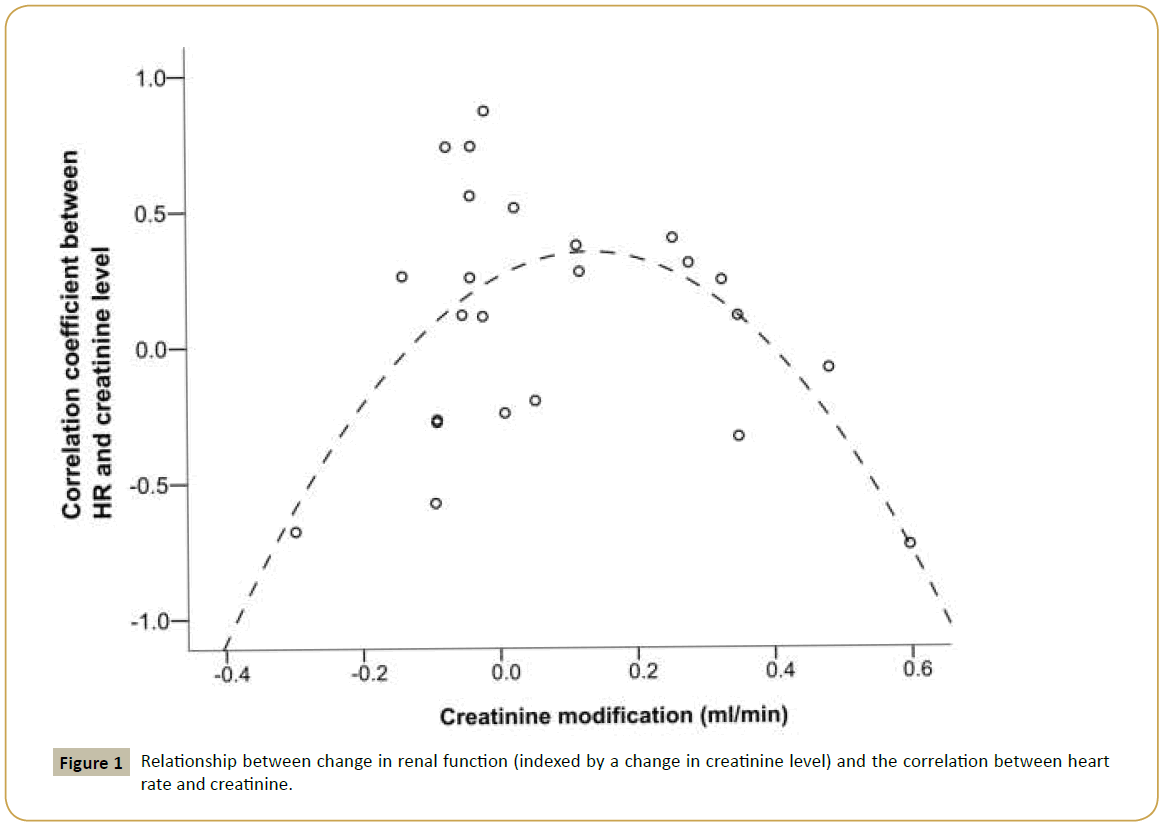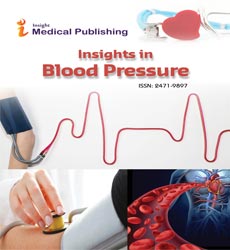Relation among Blood Pressure, Heart Rate and Creatinine in Kidney Transplanted Patients
Davide Viggiano and Rosa Maria Pollastro
Department of Cardio-Thoracic and Respiratory Science, Second University of Naples, Naples, Italy
- Corresponding Author:
- Rosa Maria Pollastro
Department of Cardio-Thoracic and Respiratory Science
Second University of Naples, via Pansini, 5, Naples, Italy
Tel: +39-081-253-1111
E-mail: rosam.pollastro@unina2.it
Received Date: September 15, 2015, Accepted Date: September 18, 2015, Published Date: September 25, 2015
Citation: Viggiano D, Pollastro RM. Relation among Blood Pressure, Heart Rate and Creatinine in Kidney Transplanted Patients. Insights Blood Press 2015, 1:1.
Abstract
Late graft dysfunction in subjects with kidney transplantation is a major topic of interest, and is due to immunological and non-immunological factors. Increased blood pressure and modified cardiac output is thought to play a role in this process. Here we hypothesize that the relationship between kidney function and cardiac output might be impaired in early stages of kidney allograft dysfunction. To test this hypothesis, we analyzed serial data from 27 transplanted subjects and used these data to derive the relationship between serum creatinine [Cr] and three main parameters connected to the cardiac output that is the heart rate, the systolic blood pressure and the diastolic blood pressure. The main result of the present study is that by focusing on the known relationship between renal function [indexed by creatinine levels] and heart rate or blood pressure, it is possible to show that increases in creatinine levels occur when this relationship is disrupted. In other words, when the changes in creatinine can be explained by heart rate modifications, the system is healthy. Conversely, as soon as the kidney is not responding adequately to a modification in the heart rate, a decrease in kidney function can be observed. These results suggest a new way to look at time-series data in patients underwent kidney transplantation.
Introduction
There is large interest nowadays in the identification of novel biomarkers of late graft dysfunction in subjects with kidney transplantation [1,2].
The kidney allograft dysfunction has been shown to be dependent upon many factors, both immunological and non-immunological ones [3]. Among the non-immunological risk factors are blood pressure, diabetes, obesity and cigarette smoke [4]. These factors have been largely studied in relation to cardiovascular diseases. However, it should be noted that the renal allograft itself largely modifies normal blood pressure control through two main mechanisms:
[i] the recipient subjects are under lifelong immunosuppressive therapy, which can increase the blood pressure by means of various mechanisms [5] and [ii] the kidney allograft is not innervated [6] and therefore lacks of one of the physiological feedbacks that in normal subjects control its function [7]. The innervation of the kidney, in fact, is known to be important in blood pressure control, and kidney denervation therapies are used in patients who do not respond to drugs [8]. Although it has been reported that the kidney allograft might receive a new innervation, its physiological meaning has been largely questioned [9,10]. It should be noted that it has been reported a relationship between creatinine blood levels [a marker of glomerular filtration rate [GFR] and kidney function] and cardiac output, indexed by the blood pressure [BP] and the heart rate [HR] [11]. The mechanism of such relation is probably due to the strong influence of the heart output on the GFR.
In the present paper we hypothesize that the relationship between GFR and cardiac output might be impaired in early stages of kidney allograft dysfunction.
To test this hypothesis, we analyzed serial data from a cohort of subjects and used these data to derive the relationship between serum creatinine [Cr] and three main parameters connected to the cardiac output, that is the heart rate, the systolic blood pressure and the diastolic blood pressure. According to our working hypothesis, a kidney with impairment of its function should also show impaired relationship between its GFR [indexed by Cr] and the cardiac output.
Methods
This retrospective observational study evaluated 27 adult patients, who received a deceased kidney transplant more than 5 years before. All the patients received conventional immunosuppression therapy. The main characteristic of the subjects [anthropometric measures, years after transplant, blood chemical data] is reported in Table 1. For their follow-up, subjects have been studied 6 times per year for two years. For the present study, only 10 temporal points per subject have been used [20 months]. Three patients have been excluded from the study because the time series was incomplete. In the present study we further analyzed the creatinine levels, blood pressure and heart frequency collected during the follow-up period.
| Variables | |
| Age | 46 ± 12 years |
| Weight | 72 ± 9 Kg |
| Sex | M = 13; F= 11 |
| Serum Creatinine | 1.3 ± 0.497 mg/dl |
| Time from the transplantation | 13 ± 8 years |
| Systolic blood pressure | 135 ± 16mmHg |
| Diastolic blood pressure | 83 ± 11mmHg |
| Heart rate | 76 ± 11 bpm |
Table 1 Characterization of the cohort (values represent mean ± SD).
Statistical analysis
For each subject we calculated
[i] The change in creatinine level from the beginning to the end of the 20 month follow-up period and
[ii] The correlation coefficient between plasma creatinine and blood pressure or heart rate. Finally, the relationship between the change in creatinine and the creatine-BP or Cr-HR correlation was evaluated using correlation analysis [Pearson coefficient] and then linear regression analysis, with a linear model and a quadratic model. The rejection level for statistically significant association was set at p=0.05.
Results
The relationship between blood pressure and creatinine levels in the same subject over time was very variable among subjects, with some patient exhibiting a strong positive correlation [higher values of creatinine correlated with higher values of blood pressure during the 10 months observational period], absent or even inverse. We then analyze whether this large variability could be linked to the functional status of the kidney and its deterioration over time. Therefore, we analyzed the possible link between a change in creatinine levels over time (indexing the modification of the kidney function) and the correlation of heart function (blood pressure or heart frequency) and the creatinine levels.
This correlation analysis did not show any significant relationship between the change in creatinine levels over time and the dependence of creatinine on systolic blood pressure or heart rate [p>0.05]. We therefore conducted a regression analysis using a quadratic model. Also in this case there was no statistical link between the change in creatinine levels and the dependence of creatinine on blood pressure [systolic or diastolic]. However, as shown in Figure 1, there is a non -linear relationship between the change in creatinine level and the heart rate-dependence of creatinine levels [R2=0.37, p=0.008].
Discussion
Most of the current literature is focused on the simple relationship between hemodynamic parameters and creatinine or on the trend in creatinine levels or other systemic parameters to explain modifications of creatinine levels in renal allografts.
The main result of the present study is that by focusing on the known relationship between renal function [indexed by creatinine levels] and heart rate or blood pressure, it is possible to show that increases in creatinine levels occur when this relationship is disrupted. In other words, when the changes in creatinine can be explained by heart rate modifications, the system is healthy. Conversely, as soon as the kidney is not responding adequately to a modification in the heart rate, a decrease in kidney function can be observed.
These results await confirmations from a larger cohort of subjects, but at present they suggest a new way to look at time-series data in patients underwent kidney transplantation.
References
- Joosten SA, Sijpkens Y, van Kooten C, Paul L (2005)chronic renal allograft rejection?: Pathophysiologic considerations. Kidney Int2005; 68: 113.
- HirtMinkowski P, De Serres SA, Ho J (2015) Developing renal allograft surveillance strategies - urinary biomarkers of cellular rejection. Canadian journal of kidney health and disease2: 28.
- Filippone EJ, Farber JL (2015)Humoral Immune Response and Allograft Function in Kidney Transplantation. American journal of kidney diseases?: the official journal of the National Kidney Foundation66: 337-347.
- Cravedi P, Perico N, Remuzzi G (2010) Non-immune interventions to protect kidney allografts in the long term. Kidney international S71-S75.
- Ponticelli C, Cucchiari D, Graziani G (2011) Hypertension in kidney transplant recipients. Transplant international?: official journal of the European Society for Organ Transplantation24: 523-533
- Shannon JL, Headland R, MacIver AG, Ferryman SR, Barber PC, et al. (1998) Studies on the innervation of human renal allografts. The Journal of pathology186: 109-115.
- Johns EJ, Kopp UC, DiBona GF (2015)neural control of renal function. Comprehensive Physiology1: 731-767.
- Dobrowolski LC, Bemelman FJ, Ten Berge IJM, van den Born B-JH, Reekers J a, et al. (2015)renal denervation of the native kidneys for drug-resistant hypertension after kidney transplantation. Clinical kidney journal8: 79-81.
- Grisk O, Gröne HJ, Rose HJ, Rettig R (2001) Sympathetic reinnervation of rat kidney grafts. Transplantation72: 1153-1155.
- Mulder J, Hökfelt T, Knuepfer MM, Kopp UC (2013) Renal sensory and sympathetic nerves reinnervate the kidney in a similar time-dependent fashion after renal denervation in rats. American journal of physiology. Regulatory, integrative and comparative physiology304: R675-R682.
- Liakos CI, Karpanou EA, Markou MI, Grassos CA, Vyssoulis GP (2015)Correlation of 24-Hour Blood Pressure and Heart Rate Variability to Renal Function Parameters in Hypertensive Patients. The Effect of Smoking. Journal of clinical hypertension (Greenwich, Conn.)
Open Access Journals
- Aquaculture & Veterinary Science
- Chemistry & Chemical Sciences
- Clinical Sciences
- Engineering
- General Science
- Genetics & Molecular Biology
- Health Care & Nursing
- Immunology & Microbiology
- Materials Science
- Mathematics & Physics
- Medical Sciences
- Neurology & Psychiatry
- Oncology & Cancer Science
- Pharmaceutical Sciences

